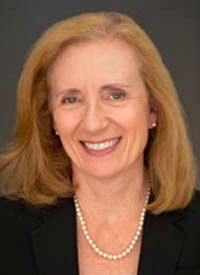Commentary
Article
Updated Breast Cancer Screening Recommendations Pave the Way for a More Equitable Future
Author(s):
Carol M. Mangione, MD, discusses the ramifications of the US Preventative Task Force’s April decision to update the breast cancer screening guidelines.
Carol M. Mangione, MD

Following the US Preventative Task Force (USPSTF) recommendation for biennial screening mammography for women aged 40 to 74 years, important calls to action have also been issued as next steps to improve care and outcomes for women with breast cancer, according to Carol M. Mangione, MD. The USPSTF indicated that there was insufficient evidence surrounding screening recommendations for women with dense breasts as well as those aged 75 years or older, and Mangione added that more research is needed to help mitigate disparities prevalent.1
The grade B USPSTF final recommendation statement for biennial screening mammography in women aged 40 to 74 years included data that indicated that 19% more lives could be saved if all women begin breast cancer screening at 40 years old. Further, Black women have a 40% higher risk of dying from breast cancer than White women.2
“This is a very important change [because] we now have adequate science to see the benefit of starting mammography at the age of 40. Our previous recommendation left it up to doctors and patients to decide what to do for women between 40 and 50 years old, but now there’s clear scientific evidence to show that it’s very beneficial to start [screening] at the age of 40,” Mangione said. “That benefit translates into saving 1 in 5 lives of women [with] breast cancer—that’s a big difference—[there] is an [approximate] 20% increase in the amount of women who survived breast cancer by starting screening at that age.”
Mangione is chief of the Division of General Internal Medicine and Health Services Research at UCLA Health in California. She is also the Barbara A. Levey, MD, and Gerald S. Levey, MD, endowed chair in medicine at the David Geffen School of Medicine, the Department of Medicine executive vice chair for Health Equity and Health Services Research, distinguished professor of public health at the UCLA Fielding School of Public Health, director of the UCLA Resource Center for Minority Aging Research/Center for Health Improvement of Minority Elders, and director of the UCLA CTSI Workforce Development Program.
In an interview with OncLive, Mangione dove into all aspects of the guidelines, citing areas where research is needed regarding the calls to action, how the earlier screening age beginning at 40 years old may save lives, and the rationale behind screening every other year vs annually.
OncLive: Due to the guidelines being insufficient regarding the benefits and harms of screening mammography in women 75 years of age and older, how would you approach a patient who is 75 years or older in your practice?
Mangione: The reason why we don’t have a recommendation for women 75 years of age and over has to do with the fact that women 75 and older were never included in the clinical trials of mammography. When we look at the modeling data vs other well done observational studies, we see conflicting results. Some studies show benefit and other studies don’t. When we’re in that situation we can’t make a solid recommendation which is why we have a vigorous call for additional research in this age group.
In my own practice, I treat a lot of older adults as well as older women, and we have a conversation and take a holistic picture [regarding] whether to screen more [frequently] or to follow the guideline and to stop at 74 years old. It depends on who the person is, what their medical conditions are, what their risk factors are, and then it’s a judgment call because we don’t know whether it’s a good idea to recommend screening in that age group.
I’m not certain about whether there are trials planned at this point [to look at testing in women 75 years of age or older], but we have made a very vigorous call for trials. The USPSTF regularly meets and talks to individuals at the National Institutes of Health and other funders of research, to encourage them to fund the studies that would help close these serious knowledge gaps in terms of what the best practices are for women over 75 years of age.
What are your thoughts on screening every other year vs every year?
We looked closely at this question—it is a very important question. One of the ways to look at this is to use the modeling data. We’ve never had a randomized clinical trial [evaluating the] use of mammography every year vs every other year, so we don’t have clinical trial data. We do have some observational studies, but more importantly, when we looked at the models when you compare every other year to annual, you’re accepting a 50% higher false positive rate. A false positive means that you’re telling a woman that she may have cancer when she doesn’t, and a small percentage of those cases would lead on to overdiagnosis [where] somebody could get treatment for breast cancer when they do not need it.
When we looked [at] the benefits of the slightly increased cases that you would find if you screened annually vs the potential harms associated with the much higher rate of false positives, in the balance the benefits and harms looked much better for every other year rather than every year. I believe we do see a lot of false positives. [Regarding] annual screening over the course of a screening lifetime—from say age 40 to 74—[approximately] every woman screened would be predicted to have at least 2 false positives in their lifetime. It is a high rate [for] screening over the lifetime if [done] annually vs every other year [and] the rate of false positives is almost half as many if you do it every other year.
What can be said about the need for more information for women with dense breasts?
There is a serious need for more information here. Approximately half of the women in the US have dense breasts—it’s very common—and in many states, it’s legislated that you have to say on the mammography report when somebody has dense breasts and that we know the mammogram doesn’t work as well. It works, so we don’t want to send a message out there saying that women with dense breasts should stop getting mammography, they most certainly should continue to [receive them]. But we have to understand that it doesn’t work as well as in women with breasts that are not dense.
There’s an interest in understanding whether there are additional tests that could be done to help find breast cancers in women with dense breasts, but at this point we don’t have sufficient science to justify selecting one of those tests or knowing what interval to do them at. This is another area where we have a very vigorous call for research to better understand the value of supplemental testing in terms of finding early cancers [and] making sure that all women with dense breasts get cancer diagnosed [when present] and have high quality and length of life.
The guidelines also mentioned potentially a breast ultrasound or MRI for women with dense breasts. Do you think that this is where the future is headed for screening?
These are 2 tests where it’s going to be very important to study their effectiveness more. Will there be a new test on the horizon that works better? There may be, we don’t know, but we do know that a lot of attention is being paid to artificial intelligence assisted readings of mammography. However, at this point, I would say the call for additional research is to understand whether doing a subsequent ultrasound or an MRI is helpful in finding breast cancers in women with dense breasts.
What was highlighted in the new guidelines in terms of mitigating disparities?
One of the things that has been known for a long time is that Black women are diagnosed with breast cancer at a younger age [compared with White women] and tend to get a more aggressive form of breast cancer. This leads to a 40% difference in mortality for Black women who get breast cancer compared with [White] women. This is a terrible health disparity, and we need to have a deeper understanding of what’s driving that health disparity. We have a call for research along the whole continuum of care—from screening to diagnosis to treatment—to see [what] might be driving that big difference in mortality.
The good news is by going from 50 to 40 years old [regarding when women should begin recommended screening], our models show that Black women will benefit the most. This is one way to start to decrease that terrible disparity, but screening alone will not take care of it. We have a very vigorous call for additional research to better understand the best screening practices [as well as] diagnostic and treatment practices in Black women so that one day we don’t have this huge difference in mortality by race.
What type of research is needed to help mitigate disparities in breast cancer?
We need to understand for women in their 40s [whether] it’s possible that annual mammograms may be more effective in Black women. We need a trial comparing annual screening with every other year screening, and we need that trial to have sufficient numbers of all women and Black women so that we can understand the effectiveness. We need additional research about the basic biology of breast cancer: Why do Black women get this more aggressive form of breast cancer that has a different marker pattern than average breast cancers do? We don’t know what’s driving that.
We also need more evidence on what helps patients adhere to treatment when they get breast cancer. Are Black women getting equal access to those services that make sure they get the best evidence-based treatments and [do they receive] help with adhering to them so that they can have the dividend of quality of life and survival from that? The call for research is along that whole continuum.
What is your take-home message for your colleagues regarding these updated guidelines?
All women should start screening at the age of 40 and should get mammograms every other year, particularly Black women because they are going to get the most benefit from starting at the age of 40. Our goal with these recommendations is to find breast cancers early and to have effective treatments so that women can have a high quality of life and a longer life. I hope that simple message of starting at 40 years old and getting the exam every other year gets out there in the public, and that people are able to access those services.
References
- US Preventive Services Task Force, Nicholson WK, Silverstein M, et al. Screening for breast cancer: US Preventive Services Task Force recommendation statement. JAMA. Published online April 30, 2024. doi:10.1001/jama.2024.5534
- Final recommendation statement breast cancer: screening. US Preventive Services Task Force. April 30, 2024. Accessed April 30, 2024.https://www.uspreventiveservicestaskforce.org/uspstf/recommendation/breast-cancer-screening#bcei-recommendation-title-area









